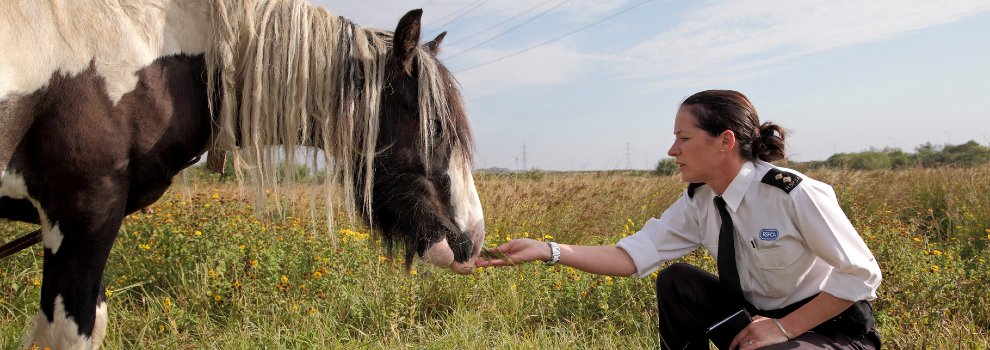- Find a Pet
- Advice and Welfare
- Ways to Give
- Get Involved
- What We Do
- Search
- My RSPCA
- Report a concern
- Sponsor
-
Colour modeVivid Calm
- Home
- Advice and welfare
- Pets
- Horses
- Health and welfare
- Tethering
Tethering horses
A tethered horse is one that's restrained with a rope, chain, strap or cord to stop it from moving outside a certain radius. Seeing a tethered horse can be worrying, and it's one of the most common equine welfare issues our inspectors deal with. We've historically received around 5,000 complaints about tethered horses per year.

Is it illegal to tether a horse?
Tethering is not illegal in the UK, but it can compromise a horse's well-being so it’s not a practice we recommend. Our officers can only help a tethered horse if their welfare is affected (e.g. an injury caused by improper tethering equipment).
If a horse needs to be tethered in order to have access to grazing, it should only be for short periods of time. For the remainder of the day, the horse should have access to shelter, and a space to run free and interact freely with other horses. Learn more about the right environment for keeping horses.
Problems caused by tethering horses
Tethering negatively impacts a horse's wellbeing in many ways. A tethered horse needs high levels of monitoring, proper tethering equipment, feed, water and a degree of freedom regularly. It's not a low-cost or low-maintenance way of keeping a horse, and it's not considered to be good practice. Here are some of the problems it can cause.
Lack of shelter
In extreme weather conditions, a tethered horse must be provided with a well-fitting rug that's checked daily for signs of wear to itself or the horse. If a horse is tethered to a tree, it can become entangled and harm itself. If it's tethered on open ground, it has no protection from flies in the summer. It's also important to tether the horse in the right place, so that a hillside or dip in the ground can provide shelter.
Limited grazing
Although a limited amount of grazing may be accessible to a horse which is tethered, this grazing will soon be cropped to the floor or fouled with droppings. A tethered horse must be moved to fresh grazing regularly in order to maintain a healthy diet.
However, even this can't mimic a horse's natural behaviour of walking long distances while grazing. A horse should also have access to clean drinking water all the time. A horse left unattended may kick over a bucket of water, and then be left without water for a long time.
No company
Tethered horses can't safely enjoy the natural company and interaction with other horses that they need, especially physical interactions such as mutual grooming.
Physical safety issues
There are obvious health and welfare issues around tethering horses, including the dangers of entanglement and injury involved with attaching a chain or rope to a horse and leaving it constrained. Long-term grazing on the same ground repeatedly can also lead to a higher than normal presence of worms, or worm burden, which can be dangerous
Stopping a horse's natural behaviour
When horses are alarmed, their instinct is to run away. When a tethered horse is frightened, they can't do this. This is a very basic denial of the freedom to behave normally, and may make the horse more frightened. A tethered horse will also be unable to roll freely and safely in a chosen spot.
Concerned about a tethered horse?
If you're concerned about a tethered horse because it looks like they’re in poor condition please ring 0300 1234 999.
Read more about the code of practice for the welfare of horses, ponies, donkeys and their hybrids at gov.uk or the horse welfare code of practice at gov.wales (see appendix one of both documents).



